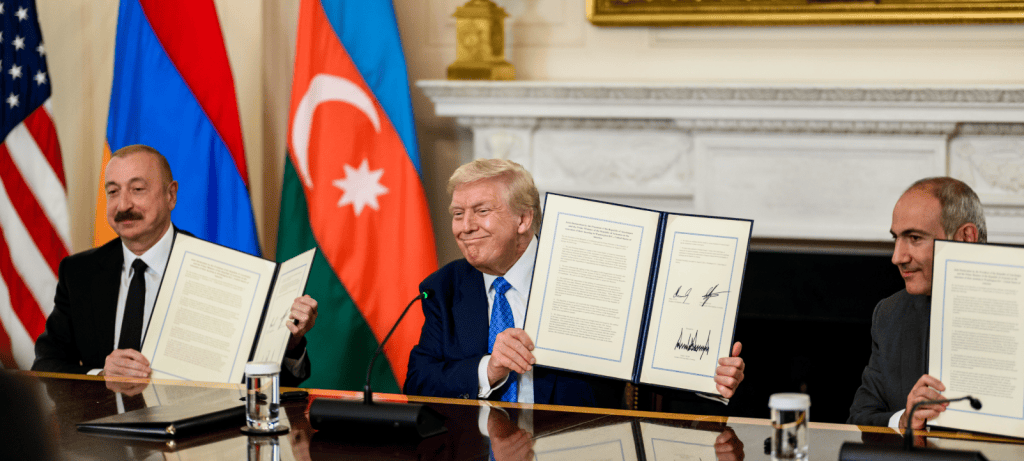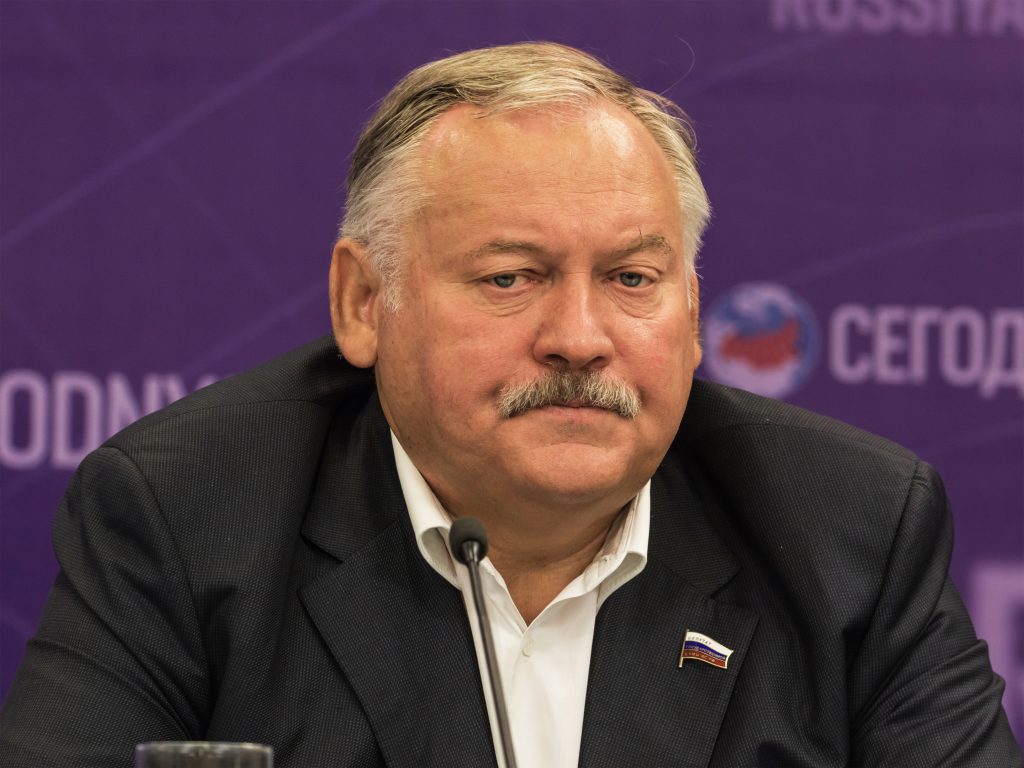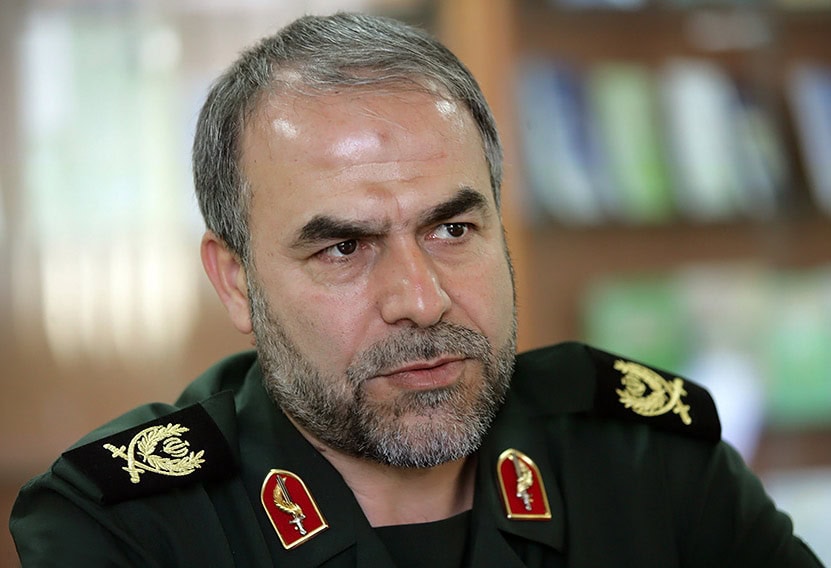Capitulation or peace—what do experts say
Peace must come only through our victory
— Monte Melkonian

On August 8, 2025, the peace agreement signed in the United States under the mediation of President Donald Trump gave new momentum to developments in the South Caucasus and drew the world’s attention.
A number of political analysts and public figures were quick to share their visions for the future and to outline the potential risks this agreement might pose—not only for the parties involved, but also for other countries in the region.
Global order developments, Russia, and the South Caucasus
Former U.S. military officer Stanislav Krapivnik presented deep and relevant observations. According to him, the opening of the so‑called “Trump Corridor” in the region will increase U.S. influence, as it seeks to bring both the political and commercial situation in the region under its control.
The United States “granted” Azerbaijan what it had been seeking for more than thirty‑four years by lifting Section 907, thereby allowing Baku to purchase American military equipment—a privilege Armenia did not receive.
It also took little effort to dissolve the OSCE Minsk Group, effectively making Washington the dominant force in shaping the regional agenda.
Because of the war in Ukraine, Russia is gradually losing its leverage in the South Caucasus, creating a vacuum that the United States and the United Kingdom may try to fill—potentially heightening tensions.
In the wake of Russia’s retreat, Turkey has become an increasingly central regional actor, which Krapivnik sees as a sign of a new balance of power and a possible source of future confrontation.
He predicts that Russia and Iran may take steps to counter the expanding Western (particularly U.S. and British) influence, which could turn the South Caucasus into a “second Afghanistan or Vietnam.” This, he says, could happen both through political involvement and through infrastructure projects.
According to his assessment, Armenia occupies a strategically important position. Signing this agreement opens several trade routes toward the West—for instance, the Abkhazian railway, which could create a new transportation corridor and expand political influence. In Krapivnik’s view, if external powers control this route, they could establish significant political leverage in the region by influencing the flow of trade and military technology.
If Armenian authorities manage to take part in managing this corridor, the country could gain transportation and economic advantages; otherwise, it risks becoming the target of international pressure.
Aliyev — pursuing Azerbaijani interests, Pashinyan — acting with the aim of betraying the homeland

Konstantin Zatulin, First Deputy Chairman of the Russian State Duma Committee on CIS Affairs, stated that this agreement pursues a single goal—to abandon Russia’s influence in the region by involving the United States in regional matters.
He noted that both Azerbaijan and Armenia are uninterested in maintaining Russian influence in the South Caucasus and are instead seeking solutions abroad.
For Azerbaijan, this may be relatively expedient, as Aliyev is advancing his and Turkey’s national interests. For Armenia, however, the agreement holds no vital significance and grants no advantage in the region, which, in Zatulin’s view, means that Nikol Pashinyan is simply betraying his compatriots by serving the interests of Turkey and Azerbaijan.
The opening of the corridor will force Armenia to make unilateral concessions

According to the assessment of the Armenian National Committee of Germany, the so‑called peace agreement has little to do with genuine peace. It is, in their view, essentially a document about opening a corridor—one that does not serve Armenia’s interests.
If its objective were truly to establish lasting peace, it should have included provisions that Azerbaijani troops must withdraw from the sovereign territory of Armenia, that the displaced Armenians of Nagorno‑Karabakh must return to their homeland under international security guarantees, that all border blockades must be lifted so Armenia can trade freely and use its transport routes, and that the Armenian prisoners awaiting sham trials in Baku must be repatriated to Armenia.
None of these points were included in the agreement, making it an exclusively commercial document that effectively challenges Armenia’s sovereignty while providing no mechanism to protect its economic interests.
Aliyev and Pashinyan are on the path to repeating Zelensky’s mistake

Yadollah Javani, the political deputy of Iran’s Islamic Revolutionary Guard Corps, reacted negatively to the signed agreement, stating that it will destabilize the situation in the South Caucasus.
According to him, both countries have fallen into the trap laid by the “gambler” Trump, by drawing the United States, the United Kingdom, and NATO into the region while ignoring the interests of their neighbors.
He noted that Armenia and Azerbaijan are repeating the same mistake Zelensky made — inviting NATO into Russia’s traditional security zone, which led to Russia’s attack.
By leasing the Zangezur corridor to the United States, Armenia and Azerbaijan are provoking Russia, India, China, and Iran.
Armenia — as a point of collision among several countries

Turkologist Varuzhan Geghamyan described the signed peace agreement as a document serving the interests of Azerbaijan and Turkey.
It in no way represents Armenia’s interests or addresses post‑war issues such as the withdrawal of Azerbaijani troops, the return of prisoners, or the liberation of Armenian territories.
The only concrete element is the already de facto established “Zangezur Corridor,” which is seen as an ideal mechanism for eventually taking control of Meghri and Syunik.
This time, however, it was presented in a slightly subtler and more polished form—veiled under the name of “peace.” In Geghamyan’s assessment, the route that first took shape under American and later Turkish mediation will, quite literally, crawl toward Syunik.
As a result of all this, Armenia is losing the support of Russia and Iran while increasing Turkey’s influence in the region. In three days, according to his expectation, the pre‑signed text defining relations with Azerbaijan will also be published—one that, he predicts, will concern new enclaves and concessions.
The peace agreement — a geopolitical jackpot for Turkey and Azerbaijan, a strategic victory for the United States, and a dangerous trap for Armenia

Gevorg Almasyan considers the peace agreement to be nothing less than a geopolitical jackpot for Ankara, which has long dreamed of realizing the idea of pan‑Turkism.
The proposed corridor, to be under U.S. supervision for 99 years, would serve Turkey as a route toward Central Asia.
The opening of the corridor also strengthens Turkey’s position within NATO, since by gaining access to—and influence over—the Eurasian route, Turkey acquires leverage over energy exports to Europe, thereby turning itself into an indispensable player for both Brussels and Beijing.
By acting as the “guardian” of the corridor, the United States effectively nullifies Armenia’s sovereignty in that zone; any incident could be interpreted as an attack on the U.S., potentially compelling Western intervention.
Meanwhile, Iran’s influence in the South Caucasus has diminished significantly. The corridor bypasses Iran altogether, excluding it from the trade route to Central Asia. In Almasyan’s view, the terms of the agreement are likely to shift in the future amid increasingly explosive circumstances.
The opening of the corridor — a source of long‑term instability and a dangerous precedent

According to Ara Toranian’s explanation, under this agreement Armenia gains nothing tangible—only some vague form of American support. The shifting nature of U.S. policy, he notes, has already shown its true face during the conflicts in Syria, Iraq, and Afghanistan.
Meanwhile, the benefits gained by Azerbaijan are obvious—a much easier connection to Nakhichevan, conveniently presented under the label of an international project, and the dissolution of the Minsk Group.
Syunik is the cornerstone of Armenia’s territorial map and its strategic key. Transferring control of it to an external actor—namely the United States—creates a real breach through which Azerbaijan and Turkey could easily penetrate.
For Iran, whose connection to the Caucasus runs through Syunik, this situation may be seen as an indirect attempt at encirclement, prompting a proportional response.
The current period is also opportune for pan‑Turkism, the movement seeking to unite the Turkic peoples of Anatolia and Central Asia. The Armenian “lock” that has stood in the way of that goal, Toranian warns, is now being voluntarily opened by Yerevan.
Soon, Yerevan will likely receive promises of investments and assistance—but these will be negligible compared with what Armenia stands to lose: its sovereignty.
Trump is acquiring territorial authority in Armenia

From Alex Christoforou’s perspective, Armenian Prime Minister Nikol Pashinyan has effectively sealed Armenia’s fate by “gifting” the Nakhichevan corridor to the United States for 99 years.
Under the guise of peace, he is inviting American forces into Armenian territory without any guarantee that it will remain part of Armenia. Christoforou also noted that last month the Spanish outlet Periodista Digital reported Armenia’s alleged intention to hand over a strategically important corridor to the U.S. in exchange for peace.
The Armenian side dismissed that claim as false information and manipulative propaganda. In Christoforou’s view, the real winner in this situation is Turkey, which will gain an opportunity to strengthen its influence in the South Caucasus.
And if a military or any kind of conflict later arises between Armenia and Turkey, the U.S. will almost certainly take Turkey’s side.
He also voiced concern regarding Cyprus and Greece, expressing hope that these countries are aware of the possible expansion of Erdoğan’s influence and will remain cautious and well‑informed.
Under the name of peace, Pashinyan handed over the Zangezur corridor to Aliyev

Suren Surenyants, chairman of the Democratic Alternative Party, outlined a number of advantages that Azerbaijan gained as a result of the agreement.
For Armenia, he said, an extremely unfavorable situation has arisen because Azerbaijan co‑signed a document concerning the sovereign territory of the Republic of Armenia. That effectively makes a legitimate part of Armenia a contested area.
This, in turn, could set a precedent implying that similar arrangements might be imposed on any portion of Armenian territory. The Nagorno‑Karabakh issue, meanwhile, is now effectively closed as a conflict since the document makes no mention of it. Azerbaijan also achieved the suspension of U.S. Section 907—something it had been striving for over thirty‑four years.
Aliyev clearly stated that his constitutional demand toward Armenia has now become an international one, and failing to fulfill it would constitute direct disrespect toward the United States.
During the press briefing that followed the signing, Pashinyan noted that border‑delimitation processes were still underway and that territories belonging to Azerbaijan but under Armenian control should be returned—without any mention of the return of lands belonging to Armenia.
Surenyants described a painful and dangerous scenario: what happens to Armenia if Azerbaijan joins the U.S. and Israel in a war against Iran in exchange for Syunik? In that case, Armenia would, in his words, function as small change in an anti‑Iranian struggle.
Trump’s chief objective, he argued, was to eliminate Russia’s presence from the region and to secure strategic advantage over Iran—while Armenia played the role of scenery in that process. According to Surenyants, this agreement can therefore be regarded as a document of capitulation for Armenia.
Even the accord signed on November 9 was, by comparison, the lesser evil, as it at least contained references to Armenia’s and fragmented Artsakh’s sovereignty. By contrast, the new one contains no firm guarantees of Armenia’s independence or sovereignty.
Surenyants also emphasized that the agreement calls China’s interests into question, since the corridor is intended to block or undermine the Belt and Road routes.



